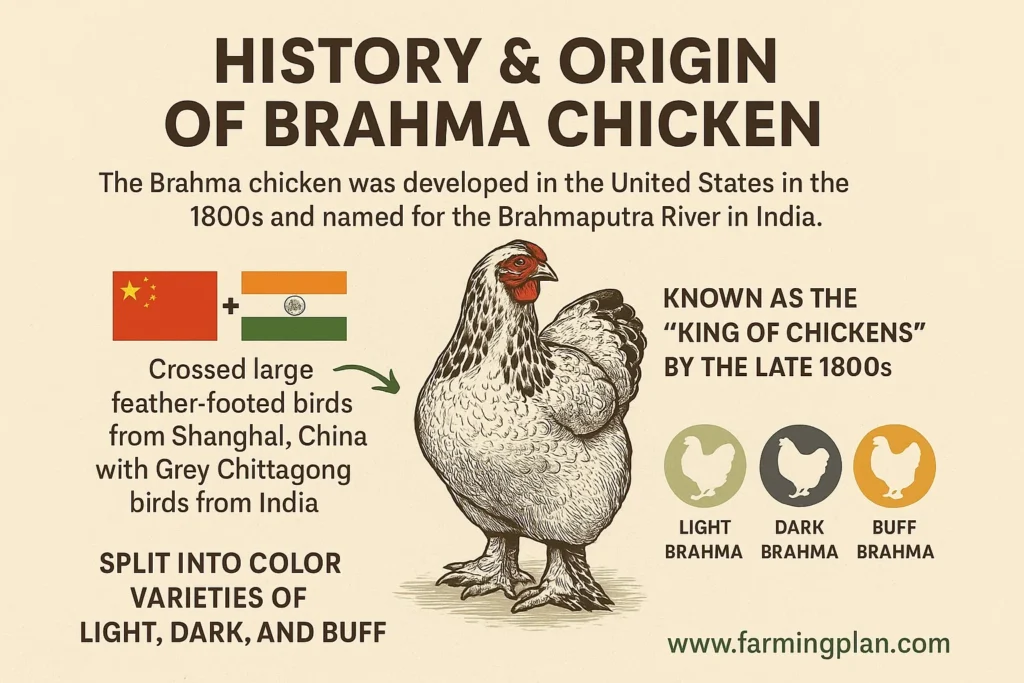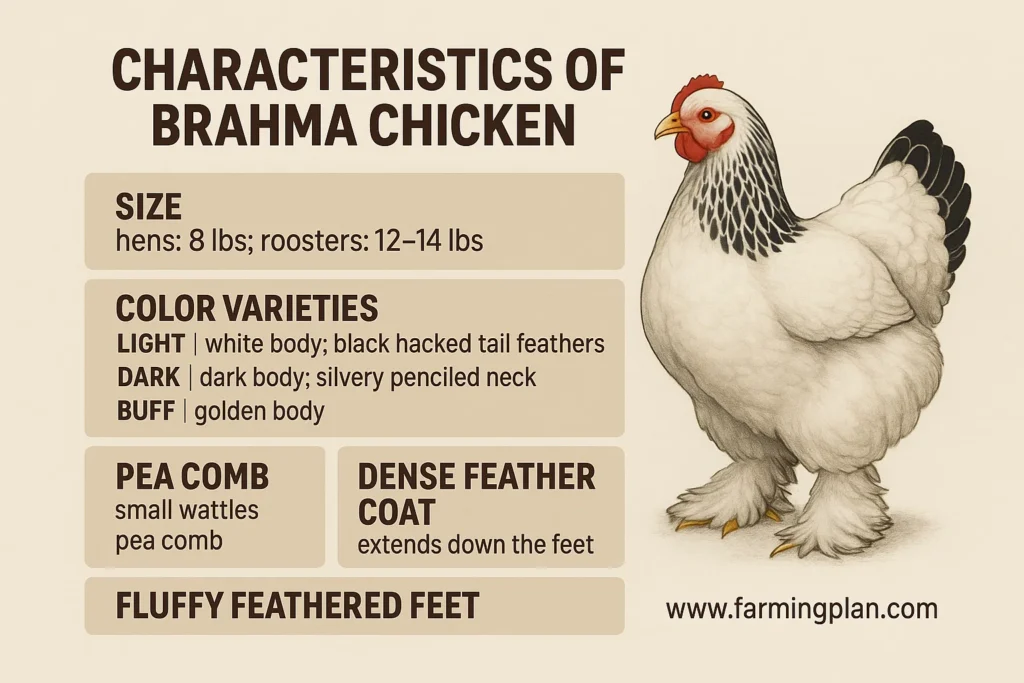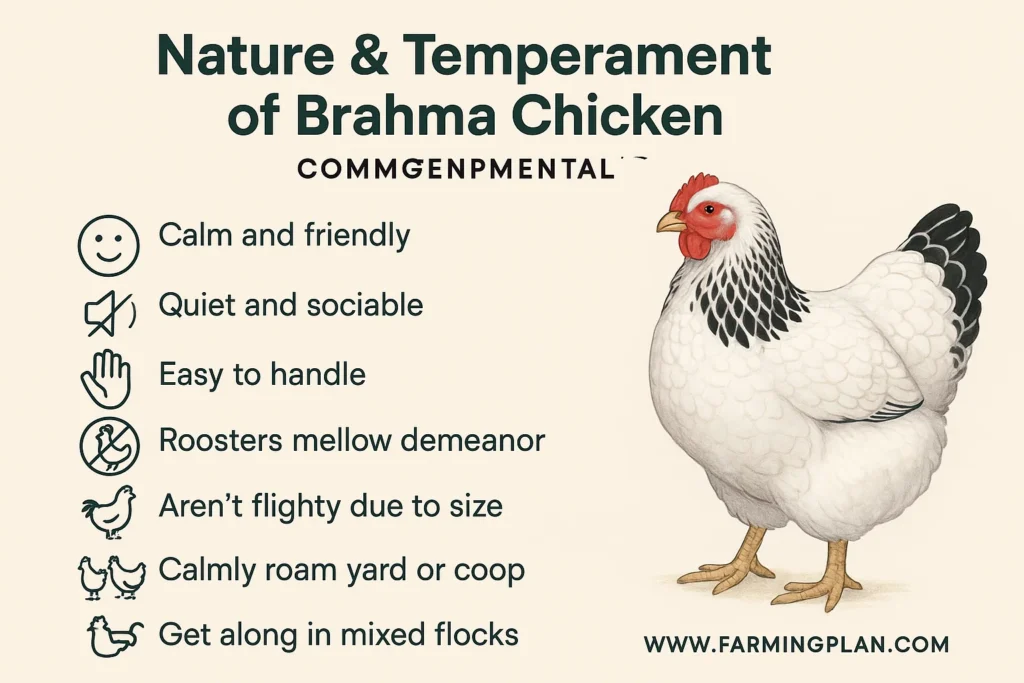If you’re into backyard chickens or just starting your first flock, Brahma Chickens are a fantastic choice. Known as gentle giants, they’re calm, cold-hardy, and have charming feathered feet. Whether you prefer Light, Buff, or Dark Brahmas, each variety adds beauty and personality to your coop. I’ve raised many breeds, but Brahmas have earned a special spot on my farm for their sweet nature and dependable egg-laying. In this guide, I’ll cover everything you need to know—from their history and diet to egg production, health tips, and daily care.

History & Origin of Brahma Chicken
The Brahma chicken has a rich and mysterious origin. Most folks believe it was developed in the United States in the 1800s, though it’s often linked with birds from India—hence the name “Brahma,” which nods to the Brahmaputra River. Brahmas were actually created by crossbreeding large feather-footed birds from Shanghai, China with Grey Chittagong birds from India. The goal? To produce a hearty, winter-hardy, meat-producing bird with some style. And boy, did they succeed.

By the late 1800s, Brahmas were known as the “King of Chickens” due to their size and popularity in both meat production and poultry shows. Their majestic look and gentle personality made them a hit among backyard chicken keepers across America and Europe. Over time, the breed split into several color varieties—Light, Dark, and Buff—each with its own flair but the same loveable personality.
Read More: Buckeye Chicken: A Breed of American Poultry
Characteristics of Brahma Chicken
One of the most striking features of Brahma chickens is their size. These birds are truly impressive, with adult hens weighing around 8 pounds and roosters reaching a hefty 12–14 pounds. Their large, muscular frames and fluffy feathered feet give them a unique and almost cartoonish charm. I like to think of them as the gentle giants of the backyard.

You’ve got a few stunning color varieties to choose from. Light Brahmas sport white bodies with black hackles and tail feathers. Dark Brahmas flip the script—dark bodies with silvery penciled necks. And Buff Brahmas? They’re golden, like living sunshine. These birds have a pea comb, small wattles, and a dense feather coat that keeps them cozy in the coldest months. Their thick feathers extend right down to their feet, making them look like they’re wearing fluffy slippers! That said, you’ll need to keep their feet dry in wet or muddy weather to avoid health problems.
Read More: Java Chicken: Farming What You Need to Know
Nature & Temperament of Brahma Chicken
When it comes to temperament, Brahma chickens are some of the calmest and friendliest I’ve ever worked with. They’re quiet, sociable, and incredibly easy to handle—even the roosters tend to be mellow. This makes them an ideal choice for families with children or for anyone new to chicken keeping.

Because of their size, Brahma chickens aren’t flighty. They don’t try to hop fences or cause a ruckus. Instead, they calmly roam the yard or coop, happily scratching around for bugs and feed. They also get along well in mixed flocks. I’ve kept Brahmas with Orpingtons, Rhode Island Reds, and even a few bantams. They never bullied or got bullied—just kept to their gentle selves. If you’re looking for sociable backyard chickens with excellent temperaments, Brahmas are a top-tier choice.
Read More: Penedesenca Chicken: Raise Happy, Hardy Birds
Food & Diet
Feeding Brahma chickens isn’t complicated, but you do need to fuel their big bodies right. I always start my chicks on a high-quality starter feed with around 20–22% protein. Once they hit about 8 weeks, I switch to grower feed.
Adult Brahmas do great on layer pellets that offer 16–18% protein. During winter or molting season, I add in some extra protein sources like mealworms or black oil sunflower seeds. These help with feather regrowth and egg production.
Also, don’t forget grit and oyster shells. Grit helps with digestion, and oyster shells keep their eggshells nice and strong. As treats, I offer veggie scraps, cracked corn in cold months, and scratch grains in moderation.
One tip: Because of their feathered feet, keep their feeding area clean and dry. Wet, dirty areas can lead to foot infections or frostbite in cold climates.
Usage & Purpose
Brahmas shine as dual-purpose chickens. They’re excellent layers of medium to large brown eggs and also make a solid meat bird thanks to their size and build. This dual-purpose nature makes them a practical and resourceful addition to any homestead. On average, a Brahma hen lays about 150–200 eggs a year, especially during the colder months when other breeds slow down. That’s why I call them my “winter warriors.”
Their large size and calm nature also make them fantastic for poultry shows and homesteads where sustainability and temperament matter. You might even spot bantam Brahma chickens in shows—they’re tiny versions of the big ones but with just as much charm.
Special Features
The Brahma’s most striking feature is its sheer size. These birds can stand nearly two feet tall, making them one of the tallest chicken breeds. Their colossal size isn’t just for show—it also means more meat and better cold tolerance. This unique trait is sure to intrigue any poultry enthusiast.
Another standout trait is their feathered feet. While other breeds have scaly legs, Brahmas have fluffy leg plumage that looks beautiful and helps in chilly winters. But you’ll need to maintain foot hygiene. They also have a surprisingly quiet temperament for their size. Unlike some other breeds, Brahmas don’t squawk or crow excessively. They’re steady, gentle, and don’t stir up trouble. It’s this combo of beauty, brains, and brawn that makes them so special.
Don’t Let Their Size Fool You—Brahma Chickens Are The Sweethearts Of The Coop!
Health Issues & Prevention
Like all chickens, Brahmas can face health challenges, but with proper care, they’re quite hardy. Because of their feathered legs, they’re more prone to foot problems like scaly leg mites or mud clumping. I always make sure their coop floor stays dry and well-bedded. Watch for signs of respiratory issues—sneezing, nasal discharge, or wheezing. These can crop up in cold, damp climates if ventilation isn’t right. Keep the coop well-aired but draft-free.
Also, due to their size, they need more space in the coop and run. Overcrowding leads to stress and illness. And make sure they have larger nesting boxes—trust me, your Brahma hen will thank you! Regular dust baths, parasite checks, and good nutrition go a long way. I also worm them twice a year and keep a poultry first aid kit nearby just in case.
Step-by-Step Farming Guide
Step 1: Preparing The Coop And Run
Brahmas need space. I make sure each chicken has at least 4–5 square feet inside the coop and 10–12 square feet in the run. Ventilation is key—so I install windows with mesh to let air flow without creating drafts. For bedding, I use dry straw or pine shavings. Feathered feet stay cleaner this way. I also raise the roosts at a comfortable height—these big birds can’t jump like bantams.
Step 2: Starting With Chicks
I brood Brahma chicks with a heat lamp, keeping the temp at 95°F for the first week and lowering it by 5°F each week. Their fluffy bodies need warmth but also good airflow. Feed them chick starter with clean water changed daily. As they grow, I introduce grit and a few treats like scrambled eggs or oats to build immunity. Handle them gently to tame them early on.
Step 3: Feeding & Watering Routine
I feed adult Brahmas twice a day—morning and afternoon—with layer pellets and mix in cracked corn during winter. They also get kitchen scraps like lettuce, squash, and apples. Clean water is a must. I use heated waterers in winter since they love cold climates but still need liquid water year-round.
Step 4: Daily & Weekly Care
Every morning, I check their feet, refill feeders and waterers, and collect eggs. Each week, I clean out dirty bedding and inspect them for mites or signs of illness. Feathered feet get trimmed or cleaned if clumps form. And I dust the coop monthly with food-grade diatomaceous earth to keep parasites away.
Step 5: Handling Cold Weather
Brahmas thrive in winter, but I still insulate their coop walls and make sure the roosts stay warm and dry. I skip the heat lamps—they do just fine as long as it’s draft-free. Their winter laying is a real bonus when other hens stop.
Expert Tips & Best Practices For Brahma Poultry Keepers
- Use Large Nesting Boxes: At least 14″x14″ to fit those fluffy behinds.
- Keep Coop Dry: Feathered feet + moisture = bad news.
- Choose Buff or Light Brahmas For Family Flocks: They’re calm, curious, and photogenic!
- Avoid Muddy Runs: Lay gravel or straw in wet areas to protect their feet.
- Feed High-Protein Snacks In Winter: Mealworms, fish flakes, and eggs boost their cold tolerance.
- Rotate Dust Baths: Add wood ash, DE, and sand for a parasite-free spa zone.
FAQ
How big do Brahma chickens get?
Brahma roosters can weigh up to 12–14 pounds, while hens usually weigh around 8 pounds. They’re one of the largest chicken breeds.
Do Brahmas lay eggs in winter?
Yes! Brahma hens are known for being excellent winter layers. They keep producing even when other breeds take a break.
Are Brahmas good for beginners?
Absolutely. Their calm, quiet nature makes them ideal for novice chicken keepers or families with children.
What do Brahma chickens eat?
They thrive on layer pellets, grains, vegetable scraps, and protein-rich treats. Don’t forget grit and oyster shell supplements.
Where can I buy Brahma chickens?
You can find Brahma chickens for sale at local hatcheries, poultry farms, or reputable online sellers. Prices vary by color and size.
Conclusion
Raising Brahma chickens has been one of the most rewarding parts of my poultry journey. They’re not just stunning to look at—they’re calm, cold-hardy, and incredibly dependable in both meat and egg production. Whether you’re after giant chickens for meat, dependable egg layers for winter, or just friendly flock members, Brahmas tick all the boxes. Their feathered feet and quiet charm make them perfect for beginners and seasoned keepers alike. So if you’re ready to add a true gentle giant to your backyard, the Brahma chicken might just be your perfect pick. Go ahead—give these lovable giants a place in your coop!

